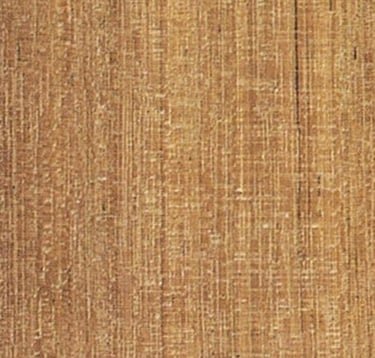Algarrobo


Hymenaea courbaril
General Description
Color/Appearance: Heartwood ranges from a light orangey brown to a darker reddish brown, sometimes with contrasting darker grayish-brown streaks. The color tends to darken with exposure to light. The sapwood is a light grayish-yellow, clearly demarcated from the heartwood.
Grain/Texture: The grain is usually interlocked, with a medium to coarse texture. It has a good natural luster.
Vessels: Diffuse-porous; large pores, very few; solitary and radial multiples of 2-3; mineral deposits (dark brown) occasionally present; parenchyma vasicentric, confluent, and marginal; rays narrow to medium, normally spaced.
Weather Resistance: It is very durable in terms of rot resistance and is also resistant to termites and most other insects. However, it is susceptible to marine borer attacks.
Workability: It is considered difficult to work due to its density and hardness, and it has a moderate blunting effect on tool cutters. Algarrobo also tends to be difficult to plane because of its interlocked grain. However, Algarrobo glues, stains, turns, and finishes well. It responds well to steam bending.
Odor: No characteristic odor.
Physical Properties
Distribution: Central and South America, Mexico.
Tree Size: 100-130 ft (30-40m) in height, 2-4 ft (.6-1.2m) trunk diameter.
Average Dried Weight: 57 lbs/ft³ (910 kg/m³).
Specific Gravity (Basic, 12% MC): .77, .91.
Janka Hardness: 2,690 lbf (11,950 N).
Modulus of Rupture: 22,510 lbf/in² (155.2 MPa).
Modulus of Elasticity: 2,745,000 lbf/in² (18.93 GPa).
Crushing Strength: 11,780 lbf/in² (81.2 MPa).
Shrinkage: Radial: 4.2%, Tangential: 8.0%.
Volumetric: 12.1%, T/R Ratio: 1.9.
Local Wood Uses
For outdoor use: sleepers and cross ties. For heavy housing structures: beams, rafters, and structural frameworks. For general housing: frames, moldings, battens, doors, shutters, ceilings, baseboards, shoe racks, and wood paneling. It is also used for floors, parquet, and stair treads. It's suitable for the manufacturing of high-quality furniture, sports equipment, toys, tool handles, agricultural handles, and turned parts.
Non-Wood Uses
Human food, medicinal, and landscaping uses. The bark contains a gum, called copal, which is used in the manufacturing of special types of varnishes and sealers.
Tree Description
Botanical Description
A semi-deciduous tree, 8 to 15 m in height and 40 to 80 cm in DBH, reaching up to 20 m in height and 200 cm in DBH, with no buttresses.
Trunk: Straight, cylindrical.
Branching: Racemose and irregular.
Crown: Large, rounded, with dense foliage.
Bark: Up to 10 mm thick. The outer bark is light gray, almost smooth to rough, with small superficial furrows. The inner bark is pink and exudes a burgundy-colored resin.
Leaves: Alternate, compound, coriaceous, with two glossy leaflets, with unequal bases, 6 to 14 cm long by 3 to 5 cm wide.
Flowers: White to beige, grouped in terminal racemose inflorescences, with an average of 14 flowers.
Fruits: A woody, indehiscent, semi-cylindrical, hard, slightly compressed, shiny brown pod, covered internally by a fleshy, floury pulp with a characteristic sweet and edible odor.
Natural Habitat
Characteristic of the interior of primary forests, occurring from Mexico to southern Brazil. In the forest, individuals are spaced out from each other. It is a long-lived tree, being a late secondary climax or light-demanding species. This species is characteristic of the Semi-deciduous Seasonal Forest, in the Submontane formation, where it occupies the dominant state. However, it can also be found in the Ombrophilous Dense Forest (Atlantic Forest), in the Deciduous Seasonal Forest of the Paraná River Valley, in Goiás, and in the Submontane Deciduous Seasonal Forest, in the lower Paraíba (Minas Gerais). In the Amazon basin, it is found mainly in primary forests on firm ground and plateaus.
Common Names
Copal tree, catfish nut, jatí and jataí oil (State of São Paulo, Brazil); burandá, courbaril, farinheira, imbuíva, jataí, Quebra facão (Bahia, Brazil); Jataí açu, jataí Vermelho, Jataí ibá, Jataí Peba, Jataí Purple, Jataí Vermelho, Jataíba, Jataicica, Jataíba Amarelo, and Jataí Anta (Minas Gerais and São Paulo, Brazil); Jatobá da caatinga, Jatobá do Sertão, Jatobazinho (Minas Gerais, Brazil); Jatobá mata (Minas Gerais, Goiás, and Piauí, Brazil); Jatobá pig and Jatobá cowboy (Piauí, Brazil); Jatobá mirim (Espírito Santo and Mato Grosso, Brazil); Jatobá miudo (Ceará, Brazil); Jatobá Santo in Espírito Santo, Jitaí (Bahia and Minas Gerais, Brazil); jutaí, jutaí açu (Espírito Santo, Brazil); jutaí de envira, jutaí mirim, jutaí pororoca and jutaúba (Brazil); jatay'va (Argentina, Paraguay); paquió, Sirari, Copal (Bolivia); Azúcar Huayo, Courbaril (Peru); Copal, Algarrobo (Ecuador); Algarrobo, Jutahy (Colombia); locust (Guyana); Guapinol (Mexico); Corobore, Algarrobo (Venezuela).
